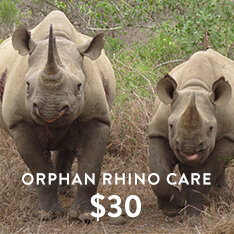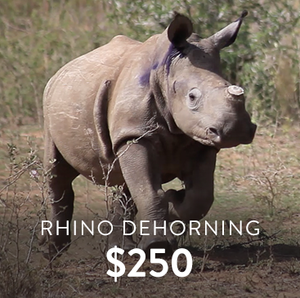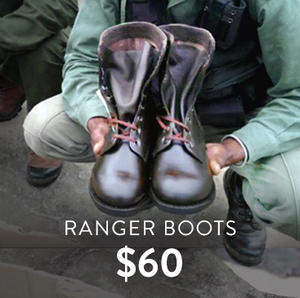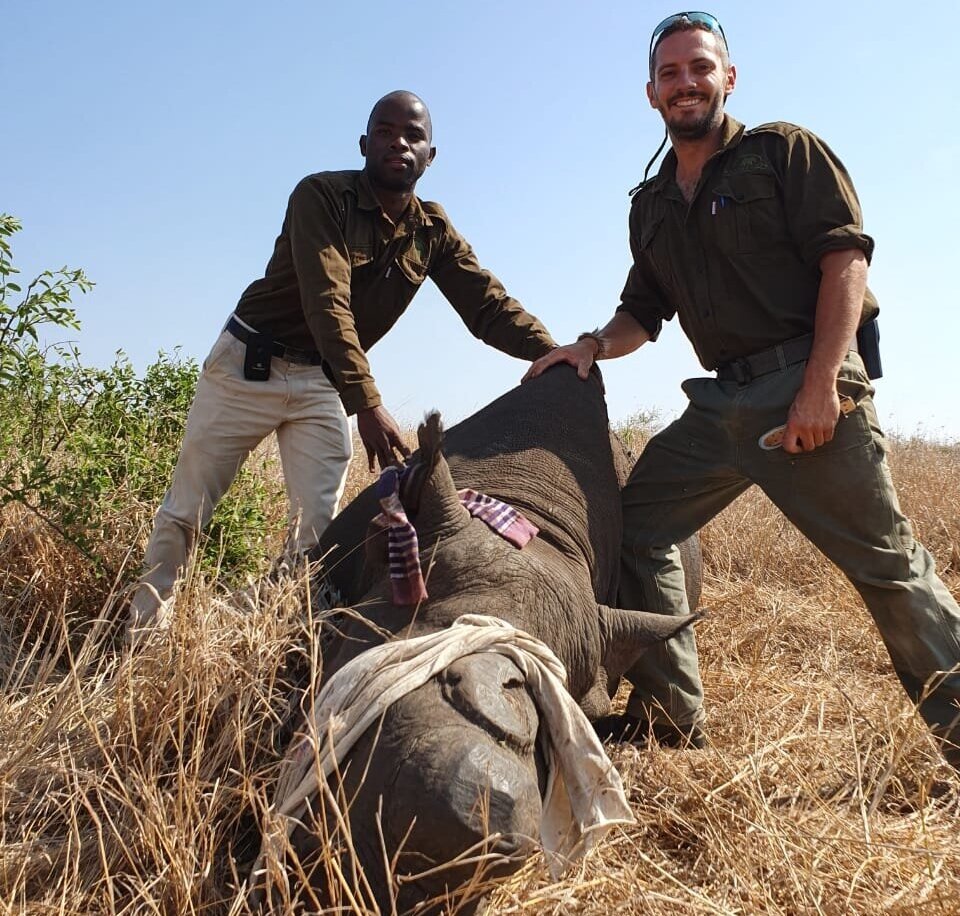HELPING RHINOS
World Rhino Day, September 22nd, is a day to remind the world about the plight of the rhino and to unite in its protection. With rhinos in South East Asia critically endangered and populations dwindling below 100, it is Africa that is home to the largest remaining population of rhinos on our planet, and where transnational criminal organizations are focusing their efforts, profiting from the destruction of the rhino species. Read more about the rhino poaching crisis, our efforts to protect rhinos in KwaZulu-Natal South Africa, and how you can help.
Volunteer Izzy Nesci works with a park ranger to measure a rhino horn before a dehorning procedure. Photo Credit: Charles Chessler
South Africa is home to nearly 80% of Africa’s last rhinos, numbering just over 20,000 individuals. 18,400 of these are white rhinos and 1,890 are the critically endangered black rhino. The incredible people we work with directly, on the ground in South Africa from vets to rangers, conservation managers, ecologists, helicopter pilots and volunteers, have been giving their all to save Africa’s last rhinos in the face of relentless poaching pressure.
Interventions to help protect rhinos include:
Deployment of heavily armed and trained anti-poaching ranger teams at wildlife reserves.
Dehorning of rhinos to safely remove the horn and disincentivize poaching.
Providing sanctuary and care for the orphan rhinos who will ultimately be returned to the wild, and
Support and employment for economically disadvantaged communities living next to wildlife reserves.
These strategies, deployed in combination, are making a difference with poaching rates declining and populations recovering in several of the private reserves we partner with. But overall, poaching rates across South Africa exceed rhino births. Government reserves in particular lack funding to employ an adequate ranger force, essential equipment and supplies, or to be able to dehorn their rhinos (a costly exercise). The fate of African rhinos hangs in the balance and they need our collective, sustained support together with political will, to tip our efforts towards population recovery for rhinos.
The fight for rhinos is far from over. Poachers have killed over 9,000 rhinos in the last 10 years, nearly two every day since the poaching epidemic escalated. You can help by supporting rangers and Wild Tomorrow Fund.
Buy boots and uniforms for rangers, the ‘thin green line’ last defense for rhinos
Help fund rhino dehorning work. It’s a last resort to keep them safe and it’s working.
Buy food for orphan rhinos. Our monthly donation program buys food and milk for the smallest, innocent victims every month for two orphanages in our region.
Donating to support Wild Tomorrow Fund’s community development work including building school classrooms, meals for school children and orphans and job creation including our Green Mambas.
You can help with support these interventions for rhinos by clicking below to donate.
According to a Department of Environment report, South Africa lost over half of all its white rhinos (51%) in Kruger National Park and 26% in other state-owned parks and game reserves in just five years from 2012 to 2017. These numbers don’t reflect the full picture, as they don’t count the baby rhinos or unborn rhinos that also died as a result of their mother’s death. It is truly a tragic, devastating ‘business’ perpetuated by organized international criminals.
Our region, KwaZulu-Natal, has the densest population of rhinos on the planet. With Kruger’s rhino population dwindling and huge investments and efforts in anti-poaching responses, the risk to poachers has increased within Kruger’s boundaries while the remaining rhinos are harder to find. The criminal syndicates behind the rhino horn trade have responded to these obstacles by moving south, hammering wildlife reserves in our region of focus, the KwaZulu-Natal Province (KZN).
Being on foot in the middle of the night on a wildlife reserve that is home to lions, elephants, buffalo and rhinos is a risk most of us would not dream of taking. Yet poachers enter wildlife reserves by cover of night and moonlight, to risk their lives to kill a rhino. Its horn could earn them a years’ salary, where rural unemployment rates are one in four.
Our ecologist Clinton Wright, holding the horn of a rhino.
For the rangers that we work with, a full moon has become a harbinger of death, a sign that the poachers are coming for their rhinos. Rangers are deployed in force for night patrols based planned around moon cycles. It’s complicated for rangers and their families, with poachers and rangers often coming from the same communities, working to make a living on opposite sides of the fight for rhino horn, driving communities into turmoil and tragedy.
It is the kingpins in the trade, in the final end markets of China and Vietnam, that profit from the killing of rhinos. Rhino horn has long be used as an Asian traditional medicine, however the recent surge in demand for horn has sent the price skyrocketing to upwards of $65,000 to $100,000 (USD) per kilogram – more than the price of gold or cocaine, making it the most expensive commodity in the world. It’s this illegal trade that is relentlessly driving rhino species to extinction.
While it’s often said or implied that the use of rhino horn is for the same usage as viagra, this isn’t actually the traditional or modern reason driving the desire to acquire rhino horn. A recent study surveyed people who admitted to using rhino horn in Vietnam, to shed light on the real reasons driving demand. They found that people used rhino horn for a number of purposes, principally as a medicine and as a status symbol. The most prevalent use was for treating hangovers. Other uses included using it to honour terminally ill relatives, who believe it may be able to cure cancer and other illnesses.
They also found that consumers preferred wild rhino horn over farmed rhino horn. And that they weren’t affected by stigma or concerned about the plight of distant rhinos. These are all important findings to uncover the true reasons for demand, and to help focus conservation solutions built on an understanding of the impulses driving the trade.
Wild Tomorrow Fund is helping in the field, side by side with rangers, vets and anti-poaching teams. We support both private and government reserves home to critically important rhino populations by donating uniforms and boots for rangers, supporting our rhino dehorning work and supporting the most innocent of victims, the orphaned rhinos. Thank you.
Sizwe and Axel work for Wild Tomorrow Fund in the field, working side by side at a rhino dehorning.
References:
Department of Environmental Affairs, South Africa. 25 January 2018. Edna Molewa highlights progress on the implementation of the integrated strategic management of rhinoceros.
Emslie, R., Miliken, T., TRAFFIC, IUCN African Rhino Specialist Group et al. (2015). African and Asian Rhinoceroses – Status, Conservation and Trade. A report from the IUCN Species Survival Commission (IUCN SSC) African and Asian Rhino Specialist Groups and TRAFFIC to the CITES Secretariat pursuant to Resolution Conf. 9.14 (Rev. CoP15).
Hoai Nam Dang Vu & Martin Reinhardt Nielsen (2018) Understanding utilitarian and hedonic values determining the demand for rhino horn in Vietnam, Human Dimensions of Wildlife, 23:5, 417-432, DOI: 10.1080/10871209.2018.1449038







